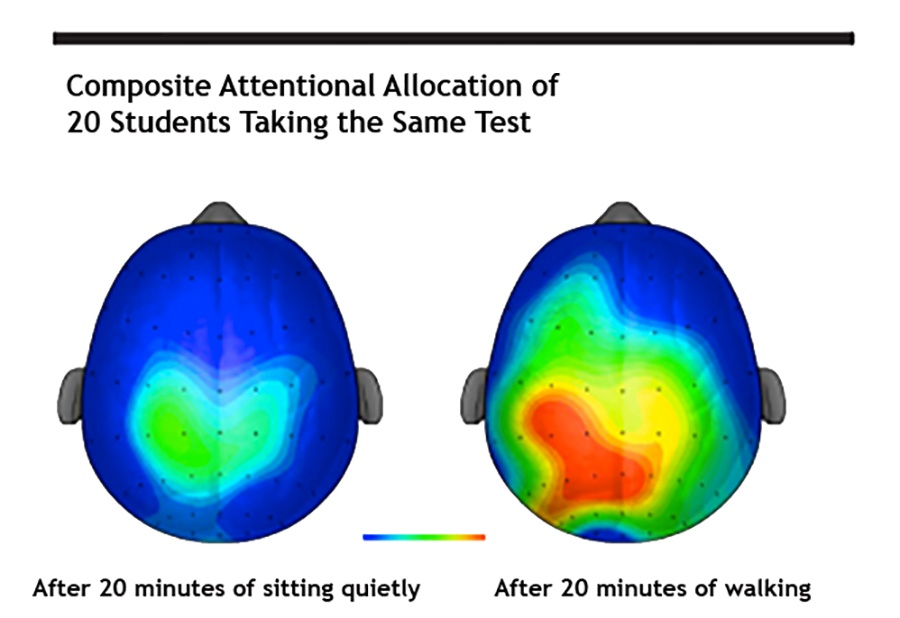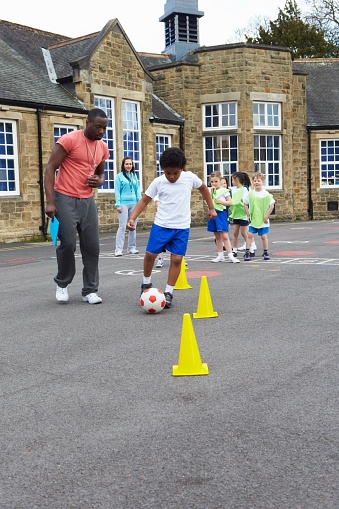Physical activity improves student performance at school
Did you know that regular vigorous exercise makes parts of a child’s brain—the parts responsible for complex learning tasks—larger and more active? Or that students who are more physically active during school perform better on standardized tests for reading, math and spelling?

These two brain images, taken from the top of the head, represent the average amount of students’ neural activity during a test following sitting and walking for 20 minutes. The color blue represents lower neural activity, while the color red denotes higher brain activity in a given region. Image courtesy of Charles Hillman, University of Illinois at Urbana-Champaign, as printed in Active Living Research’s “Active Education: Growing Evidence on Physical Activity and Academic Performance.”
Physical activity has both immediate and long-term benefits on academic performance. Almost immediately after engaging in physical activity, children are better able to concentrate on classroom tasks. They perform better on memory and recall tasks. In some studies, walking for 20 minutes before a reading comprehension test increased performance.
Physical activity also supports academic achievement in indirect ways. Physical activity among teens, for example, is consistently related to higher levels of self-esteem and lower levels of anxiety and stress.
Activity type matters
Cardiorespiratory activities, such as running and playing tag, have larger effects on academic performance than lower-intensity activities. Activities requiring more coordination—balancing, reacting, adjusting and differentiating—are associated with better concentration on academic tasks than more traditional physical education lessons that focus on team sports.
What can schools do?
Because children spend so much time at school, schools have a unique opportunity to help children become healthier and more active.

Physical Education Class
Schools can consider increasing the amount of time students spend in P.E., perhaps increasing the number of days P.E. is provided each week or lengthening class time. P.E. teachers can maximize the benefits of class by increasing the amount of active time, emphasizing cardiorespiratory fitness.
Recess
Recess isn’t just about “play” – research demonstrates that providing recess to students on a regular basis benefits academic performance, while also facilitating social development.
Across curriculum
Physical activity can be incorporated into subjects outside of P.E. Classroom teachers can include movement activities and physical activity breaks into their curriculum. Short breaks of 3-20 minutes that require little or not teacher preparation, special equipment or resources have been proven effective.
Extracurricular activities
School-based sports programs can be developed or continued without concern that these activities have a detrimental impact on students’ academic performance. School administrators can also encourage after-school organizations, clubs, student groups and parent groups to incorporate physical activity into their programs and events.
Family education
Schools can also help educate families and encourage physical activity at home by sharing 5-2-1-0 messages that reiterate the need for 1 hour of physical activity daily. Reminders, tips and resources can be shared via email, newsletters, social media, student/parent orientation handbooks and other existing communication tools.

LEARN MORE ABOUT THE LINK BETWEEN HEALTH AND ACADEMIC PERFORMANCE.
Topics: 5210, Physical Activity, Schools
Subscribe for more
Want more ideas for healthy schools, workplaces, child care providers, and families? Subscribe to our blog for weekly tips delivered right to your inbox!
Child obesity prevalence rates still rising NEXT »
Ways your child care policy can support recommended screen time for kids
